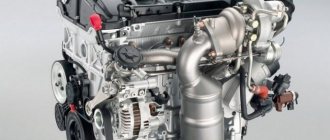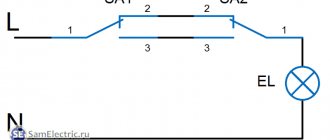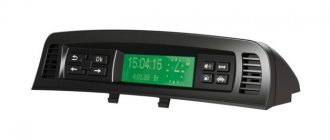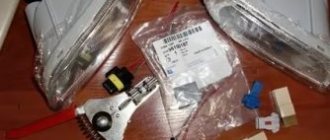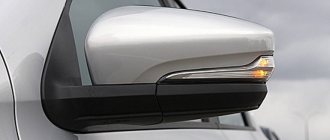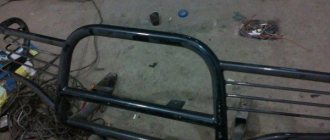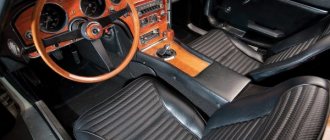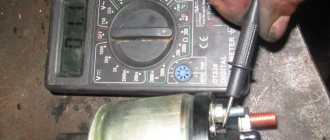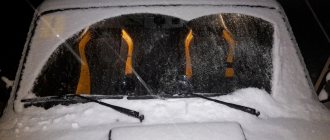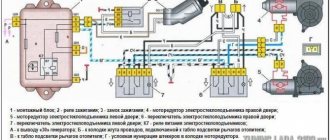None of the configurations of the Lada 4×4 SUV has front fog lights (FFL) in its list of options. AVTOVAZ did not provide them with the new model with the Urban prefix. Let's look at the features of self-installation of PTFs, as well as methods for connecting them.
Required
: PTF set
Where can I buy?
PTF for Lada 4×4 are presented in our online store.
Connection diagram
You will need: a 4-pin relay (type PC527 or 90.3747), a block with a 16A fuse, a three-position switch (for example, from a stove fan, 21070-3709608-01), wiring for power circuits (with a cross-section of at least 2.5 mm 2) and for control circuits (not less than 0.75 mm 2).
It is not recommended to connect the ground of the PTF through the headlight fastener, because During operation, corrosion may appear and contact may be lost. It is more convenient to place the relay in the engine compartment. We hide all the wiring in corrugations.
We connect the button illumination to pins 1 and 2 (take the white and black wire from any backlit button in the center console).
As a result, this connection allows the use of three modes of operation of the fog lights:
Using a similar scheme, you can install and connect headlights to the roof of a Lada 4×4 (chandelier).
Let us remind you that other improvements to the Russian SUV can be found in this category.
Source
Electrical diagram for connecting fog lights Niva 2121, VAZ 2131
Tuning the body of a VAZ 2131 with your own hands, tips for modifying the body, external tuning of the Niva 2131, VAZ 2121. Tuning VAZ cars is an increase in the factory characteristics of the car. Refinement of the Niva 2121 is, first of all, the installation of new bumpers, crankcase protection, and a winch. If desired, the owners of these SUVs install additional fog lights. Our sections describe instructions and tips for modifying the Niva 2131 of various units, such as the transfer case, etc. Even a car enthusiast can do complex tuning of vases with his own hands. You will also find categories for engine tuning, gearbox tuning, interior and exterior tuning, as well as many photo reports of VAZ 2121 tuning. Thanks to interesting solutions, Niva tuning will give you a lot of pleasure and benefits. If you have photos of tuning vases, send them to us by email.
Excellent VAZ 2121 headlights manufactured by OSVAR were chosen as fog lights. Diameter approximately 160mm. The beam is excellent, flat. The mount is strong. The housing is sealed.
Fog lights operate in 3 modes
1. Fog lights are not turned on 2. When the high beams are turned on, they turn on automatically. The high beam headlights blink together with the Niva 2121 fog lights. They do not turn on when the low beam is on.3. Always on, but only when the side lights are on (rule requirement)
Without modification, you can use a 3-position switch from the Volga GAZ 3110 stove fan, which fits in the same place as I installed. One group of contacts remains free. And if you are not satisfied with the picture of the fan on the button, then you can replace the moving part of the switch with another one, from the outdoor lighting switch of the Niva, VAZ-2109 or Volga. He placed the relay next to the switches for turning on the lighting and headlights. There are two free mounting spots next to them.
You can make an indication of the operation of the fog lights. The Niva 2131 rear fog lamp bulb is suitable for this. But it must be connected to it via a diode decoupler. To do this, you need to cut off 2 orange-black wires from pin 8 of the instrument panel connector. Solder two diodes connected together by cathodes to this contact. Connect pin 87 of the additional relay to one of them, and solder the cut wires to the second end. If you do not decouple the leads through the diodes, then when the main beam blinks, the rear fog lights of the VAZ 2131 will light up, which can be mistakenly perceived as a braking signal.
Wiring diagram for fog lights VAZ 21214
Fog lights are designed to generate a flat and wide stream of light directed above the road surface. This direction of the light beam allows minimizing illumination of the volume of fog in thickness and improves visibility from the driver’s seat. Failure to follow the rules and wiring diagram for fog lights when installing them yourself can lead to accidents.
Requirements for installing fog lights
It is permissible to locate fog lamps directly in the headlights.
The rules for installing headlights are regulated by two regulations:
Location of fog lights on a car
The general requirements are as follows:
The standards do not have special requirements for installing fog lights on a car, so the owner can install the kit himself.
What will you need to install fog lights?
To install fog lights yourself, a minimum set of tools is required. The car owner must have knowledge and skills in working with electrical wiring, since the safe operation of the car as a whole depends on the correct installation.
Set of materials required for installation:
Set of fog lights for Ford Focus 3
How to install fog lights on a Chevrolet Niva
The third one - with two thick pink wires - is the starter relay.
Installation of fog lights PTF Chevrolet Niva installation
There are plans to do something similar, but with 1W LED spot light. Shniva has received an update since the year from the Western brand Bertone. That is, if the main task of the main headlights is that they help illuminate the road surface, but the PTFs highlight the car on the road during bad weather conditions, and illuminate the road in fog.
How to install and connect with your own hands?
Installing fog lights on your own begins with developing a connection diagram. A properly designed circuit avoids unnecessary wires and ensures reliable operation of the electrical circuit. It is recommended to carry out installation work in the garage, although many owners install it outdoors.
Installing PTF in the front bumper and setting it up
There are three installation methods:
The setup is done using the homemade template presented below. The template is installed perpendicularly at a distance of 5 m from the car headlights. The adjustment is made until the top edge of the light spot coincides. The matching line is located 100 mm below the height of the center of the lamps.
Approximate view of the template for customization
Adjusting your fog lights increases driver visibility and reduces the risk of blinding oncoming drivers.
Installing PTF in a blind bumper
The most difficult and time-consuming option is to install fog lights in a solid bumper (i.e., one that does not have factory holes for this):
Installing PTF on the external bracket
Option for mounting foglights on a steel bracket:
Example of installing headlights on a bracket
Installation of PTF in standard openings
In order to install headlights in a bumper that has standard plugs, you must:
Wiring
When pulling and installing wiring, you must follow the following safety rules:
Neglecting the rules for safe installation of electrical wiring leads to overheating of the circuits and a fire, which can destroy the car.
Before starting installation, it is recommended to assemble the future electrical circuit and test the operation. This event allows you to find and eliminate errors made during development.
Wiring and headlight testing
Approximate wiring sequence:
Installation of PTF switch
The most common method of turning on the fog lights is a button installed in a regular place or at any other point within the driver’s reach. The regular places for the buttons are covered with removable plugs, and occasionally they are covered with instrument panel material. In this case, it is necessary to cut a hole corresponding to the dimensions of the button body.
A separate item worth considering is the installation of a steering column switch unit equipped with a rotary switch for fog lights. To perform the work, you may need a special tool - screwdrivers with Torx heads and a special wrench for the central bolt of the steering wheel.
To connect the steering column switch follow these steps:
An example of installing a new steering column switch on a Hyundai Solaris.
On some European cars, fog lights are switched using a rotary switch located on the instrument panel. When installing headlights on such a car, you need to connect the wires from the lamps to the plug and install a light switch with the function of controlling the fog lights.
What are PTFs?
On Shniva, this optics is a rectangular shape with 35W halogen lamps mounted inside. They are placed according to a standard layout below the main headlights, which is necessary to reduce the glare of oncoming drivers and the penetration of light through fog. If the main light is intended to illuminate the road surface, then the PTFs have the main purpose of highlighting a car on the highway with reduced visibility at a long distance and illuminating the road in fog.
Power comes from a 12V DC vehicle network. The power button is located in the Shnivy's interior and looks like a headlight with arrows pointing down. Even those models that are not equipped with PTF as standard have a connector for mounting a power button. Also, according to operational safety, the network supplying this optics consists of a relay and a fuse designed to protect the wiring from overheating. If these elements are not available, then they must be purchased if the installation of PTF is being calculated.
Inside, the design is based on lens optics, which allows it to cope 100% with the function of illuminating the road surface in fog. The lighting lamp has an H4 type base, which allows the installation of xenon lighting. The outside of the optics is covered with protective glass, which prevents fogging and does not reduce the quality of lighting.
How to install fog lights on a Chevrolet Niva
So, if you need restyling or retrofitting of a Niva Chevrolet car, namely the installation of a PTF, then everything is very simple. Even if Shniva is not equipped with this type of optics, absolutely all models are equipped with training. The preparation includes ready-made wiring, places for installing relays, buttons and a place on the bumper. Therefore, you must first purchase all the listed material and get down to business:
- The car is de-energized. The instrument panel is removed to provide access to the button connection.
- Under the panel there is a free chip wrapped with electrical tape. This is exactly what we need.
- We install the button in the panel and connect the chip.
- Next we move to the control unit where the relays are located. We find a free block, which is located second on the left, and install a new relay into it.
- Now let's proceed directly to the connection. The wiring with a chip is brought out for connection through the underwing holes of the body to the front bumper.
- So, the connection diagram is laid out. Now the last thing left is to install the PTF in the front bumper.
- The Niva Chevrolet has already prepared holes for installing standard type PTFs. You just need to install them using fasteners and you're done.
- All that remains is to connect the fog lights and check that they are working properly.
Connection diagram
Most motorists have a question related to connecting PTF. Therefore, in this section we will consider the wiring connection sequence. The connection diagram is as follows, presented below.
PTF connection diagram
The diagram shows the location of the main elements for connecting the PTF. The numbers 1 indicate the fog lights themselves with the working elements inside (lamps). The black wire is ground, which is connected to the car body. The yellow and yellow-black wires are led out to the control unit through connecting chips. Position 2 shows the connection order on the mounting block via fuses F4 and F14. The relay responsible for turning on the PTF is powered from the control unit. The relay has two wires connected to the closing contacts of the power button. When pressed, power is supplied to the relay coil, which in turn closes contact 30 (on the relay), supplying power to the lamps. The entire circuit is powered by a 12V battery, which is shown by contact pairs A and B. The connection circuit is simple and primitive, which even a beginner can handle. But this same primitive circuit is the basis for the operation of an optical device. By numbering the contacts in the diagram, you can carry out repairs in case of malfunctions of the fog lights.
Lamp for PTF
An important issue is the installation of lamps in fog lights for the Chevrolet Niva. The standard configuration of the fog lamp is equipped with a halogen incandescent lamp with a power of 35W. But such a lamp cannot produce a strong luminous flux due to the nature of low power, so many drivers seek to install other types of lamps, such as xenon or LED, in the PTF. Xenon ones are very popular, but they require the installation of an additional starting unit. The lamp produces luminous flux due to an inert gas and a special filament, which is many times superior to the good old halogens. The light from a xenon lamp pierces even thick fog due to the intensity of the flow.
Important! A high-power lamp overloads the electronics and battery, so it is not recommended to equip a car with more than four 55W lamps, especially installing cheap Chinese xenons.
The LED lamp does not have such a powerful flux, but it consumes little power compared to halogen and xenon lamps. The cost of xenon lamps remains maximum due to the additional ballast control unit and maximum performance.
PTF for Chevrolet Niva Bertone
Since 2009, Shniva has received an update from the Western brand Bertone. Now the basic package includes fog lights that are not rectangular in shape, but round. The round shape makes it more compact and individual. There was also a change in the density of glass, which is now resistant to small crushed stone and minor obstacles. The update from Bertone has significantly changed the external design of the Chevrolet Niva, which can only be recognized by the shape of the body and the front main headlights.
Fogs in the restyled Shnivy
The presence of fog lights on a Niva Chevrolet SUV is the key to safe off-road driving and more. Even if the basic equipment of Shniva does not have PTF, it would be a good idea to give your car a little update and safety.
Video
The wiring diagram for installing fog lights is shown in a video filmed for the “Car Lover” channel.
Scheme for switching on headlights and fog lights:
1 – headlights; 2 – main fuse block; 3 – relay for turning on low beam headlights; 4 – ignition switch; 5 – external lighting switch; 6 – control lamps for high beam headlights (left) and fog lights (right); 7 – fog lamps in the rear lights; 8 – fog light switch; 9 – additional fuse block; 10 – headlight switch; 11 – relay for turning on the high beam headlights.
The car has two round headlights. Headlight bulbs are double-filament (H4). The voltage to the lamp filaments is supplied through the low and high beam relay type 113.3747, located under the instrument panel on the left side. Relay characteristics: switching voltage at a temperature of (20±5)°C – no more than 8 V, winding resistance – (85±8.5) Ohm. Voltage is supplied to the relay windings if the exterior lighting switch key is fully pressed (then the choice between low and high beams depends on the position of the headlight stalk switch) or regardless of the switch position - if the driver pulls the left steering column switch towards himself (the high beam headlights turn on ).
Some cars can be equipped with a hydraulic headlight corrector, designed to change the angle of the headlights depending on the vehicle load.
PTF NIVA
The content of the article :
“Correct” connection of PTF to NIVU
When I initially installed the PTFs, I quickly connected them “directly”, i.e.
+ from the battery to the switch, and the second wire from it to the PTF. Yesterday, having nothing else to do, I decided to do everything wisely. I used a regular relay from 2110. I decided to connect the control wire to the standard rear PTF switch so that the warning light on the panel would light up (without a relay, such a connection would cause the fuse to burn out or the wiring to melt). In principle, everything is visible in the diagram, the only thing is that there is still a fuse on the + from the battery. I made one more modification (but this is a matter of everyone’s taste), replaced two wires from the PTF and side lights in the block on the rear lights, so that in normal mode the dimensions glow normally, and connected an additional rear light to the main PTF wire.
To pull the wires out of the block, you need to bend the holding tendril with something, for example I used a small hexagon.
Wires removed from the block. Before inserting into the block, the antenna must be bent again
In the end it turned out like this:
The indicator lamp lights up when the PTF is turned on
Works from near and far. The button is off, off and PTF 1 position if the low one is on and PTF 2 position if the far one is on and the PTF in this position when the near one is on the PTFs do not work when the far one blinks in this position the buttons blink and the PTF
PTF Hella Luminator Metal
It’s no secret that the standard light on the Niva, frankly speaking, is still junk. To improve the situation, I plugged into the headlights, in my opinion, very good KOITO Whitebeam lamps, but the situation remained sad. Due to the lack of light, I decided to radically combat this problem, and found a suitable solution. HERE IT IS!
The price of the issue was scary at first, but what can’t you do for your own comfort. In addition, Niva has not received gifts for a long time). I ordered PTF together with I-boost.
for some reason it says hromium on the box
if you enlarge the photo, you can see the note made with a black pen, after all, it’s Metal
We unpack the boxes and are impressed.
These are the kind of headlights the Germans make!
contents from the box
To connect the headlight “pot” and the mounting bracket, unscrew the 4 screws on the front side of the headlight with the included hexagon, remove the frame, take out the reflector and fasten it, immediately insert the H3 lamps, I installed MTF Light Platinum H3 and put everything back together. To facilitate the process of connecting the electrical wiring, I ordered a PTF connection kit on the 12v network, which came along with the windshield wiper switch and was waiting for its finest hour.
Fog light connection kit
Complete with wiring, relay and block, there is a button, it’s a pity that it is not backlit, and detailed installation instructions
Here are the instructions, by the way, it is also available in electronic version on the 12v website
On the reverse side there is a diagram for connecting and adjusting the PTF
Next you need to drill holes in the bumper and secure the headlights. We measure 40 cm from the sides and drill:
bumper with holes
The headlights look solid
try on the protective caps from the kit
We are waiting for darkness to set in and go adjust the PTF. They shine decently, in principle you can drive with only fog lights, but with a head light there is more comfort) Now I don’t feel a lack of lighting. Perhaps I will replace the lamps with KOITO Whitebeam, perhaps I will leave MTF. Now I'm thinking about changing the head optics to Hella. I was looking at the bi-xenon lensed headlights from the Gelendvagen, but the price of 16 rubles apiece is stopping me.
Main characteristics
| Make: BMW | Gearbox: automatic / manual |
| Model: X1 | Body: sedan, coupe, station wagon |
| Year of issue: 2009 | Power: petrol/diesel |
| Engine capacity: 1985 cm³ | Drive: rear |
Installing fog lights on a field does not take much time, about one hour. First you need to purchase the necessary components, in addition to fog lights, you need to take 6 female terminals, one 6 mm loop, a 4-contact relay, a button for a VAZ and 6 meters of car wire.
To begin installation, you need to attach the fog lights to the bumper, as shown in Fig. 1.
Simultaneously with installation, connect the black negative wire to the fog lamp mount and bring the positive wires under the grille to the battery area as shown in Fig. 2 - 3.
Then you need to insert the cable into the button into the interior. Under the spare wheel, closer to the engine, there is a structural rubber plug in Fig. 4.
You need to pierce it with an awl and push the wire into the interior (Fig. 5.
Next, you need to connect a wire to the right headlight of the side lights - Fig. 6, to power the power relay, we find the blue wire, strip it, connect it and lead it to the battery compartment.
As a result, after dividing the wiring, as shown in the figures, the wires should converge in the area of the battery, Fig. 7.
Correct connection on relay fig. 8: contact No. 87 - battery, contact No. 80 - fog lights, contact No. 85 - button (minus control), contact No. 86 - positive from the blue wire of the side lights.
On each wire you need to put a terminal - a mother and on the main supply - an 8 mm loop, for connecting to the battery, Fig. 9.
How to connect fog lights
The easiest way to connect fog lights is if the car is equipped with standard wiring. In its absence, you will have to manually lay conductive elements. There are two options - through a relay and through a button.
Via relay
To install PTF via a relay, you will need the following tools:
- terminal block;
- wire cutters;
- knife;
- pliers.
At the same time, you need to take corrugation, heat shrink, electrical tape and terminals. The connection sequence is as follows.
- Find a free space to install the relay. Secure it where it can be easily accessed for repair or replacement.
- Select a place to install the button.
- Measure the length of the power wires. It should be enough for free laying without tension.
- Install a 10-amp fuse and run the finished wire from pin 30 to the positive terminal of the battery.
- From pin 85, remove the wire for the power button.
- Connect the relay to ground using pin 86.
- Install fog lights on the bumper.
- Feed the negative wire from the body and the positive wire from pin 87.
- Check the lighting operation.
Via button
The button should receive voltage from any 12-volt wire. As a rule, power is taken from the plus side lights. The ignition system wiring may be fine.
Connecting the headlights themselves is simple. The red wire carries positive voltage, the black wire carries the ground bolted to the body.
Important!
Before connecting the wiring to the button, choose a convenient place for the latter on the dashboard, where you don’t have to reach too far with your hand.
